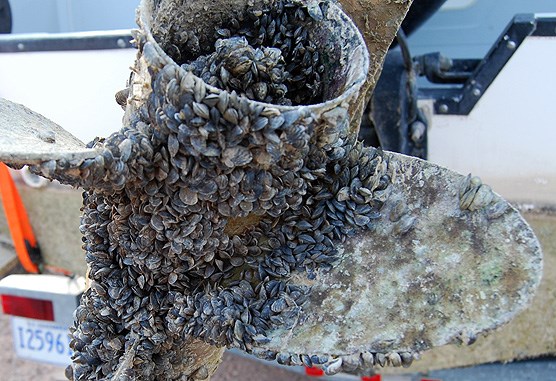As invasive mussels creep toward Wyoming, ‘dirty boats’ show up in Greater Yellowstone Ecosystem

By Billy Arnold
Jackson Hole News&Guide
Via- Wyoming News Exchange
JACKSON — Invasive mussels float down rivers as plumes of tiny larvae, latch onto boats to cross state lines and find new waters to infest. And they are inching closer to Wyoming.
One species can even survive and spread after passing through a catfish’s intestines.
But Sue Mills, Yellowstone National Park’s aquatic invasive species coordinator, isn’t ready to surrender to the ecosystem wrecking balls making their way toward the Greater Yellowstone Ecosystem.
“I refuse to be one of these people that say, ‘It’s all a matter of time,’” Mills said.
Still, this summer posed a challenge for land managers and wildlife officials who have been trying to stop zebra and quagga mussels from ever entering waters in the Cowboy State.
In Yellowstone, Mills’ staff intercepted two boats suspected to have been fouled with zebra mussel hitchhikers. They kept them from entering the water — and prevented the infrastructure-fouling, plankton-devouring mollusks from finding a place to roost.
But Yellowstone also saw a 30% increase in the number of “dirty boats,” watercraft filled with foreign material and aquatic vegetation, that approached the three motorized boat ramps where Yellowstone inspects incoming vessels.
That came as the Wyoming Game and Fish Department stopped 58 boats fouled with mussels from entering Wyoming waters, a roughly three-fold increase from 2019, the last year before the COVID-19 pandemic. Three intercepted boats in 2022 contained live mussels.
Grand Teton National Park has likewise battened down the hatches. The goal: Preventing watercraft coming from South Dakota’s Black Hills, where zebra mussels were detected for the first time this year, and other mussel hot spots from contaminating iconic waterways like Jackson Lake, Jenny Lake and the Snake River.
Chad Whaley, aquatic invasive species coordinator for Grand Teton, wasn’t optimistic about what would happen in Jackson Lake if a zebra or quagga mussel managed to slip by the park’s defenses.
“The fishery would collapse,” Whaley said.
As a park fisheries biologist, Whaley has caught and dissected his share of lake trout, the freshwater char that make up the bulk of the fish in Jackson Lake’s fishery. The vast majority of them have had bellies full of plankton, one of zebra and quagga mussel’s favorite foods. When zebra mussels caught hold in the Hudson River, phytoplankton biomass declined up to 83% in the New York waterway.
“The carpet would be pulled out from underneath them,” Whaley said of Jackson Lake trout.
Both species of dreissena mussels were first detected in the United States in the late 1980s and are thought to have been introduced to the Great Lakes from Eastern European oceans by seafaring ships that dumped their ballast tanks in America’s inland seas.
There, zebra mussels took hold first, costing Great Lakes states and provinces billions of dollars as they fought to keep pipes unclogged and water flowing. But quagga mussels, a more aggressive invader, now hold sway. As aggressive feeders that can live hundreds of feet below the water’s surface, they’ve coated the bottom of Lake Michigan at densities of over 35,000 mussels per square meter, according to the Milwaukee Journal Sentinel’s series, “A Watershed Moment.”
As the Great Lakes’ quagga mussel population has grown, they’ve also stripped plankton from the water, increasing the depths to which sunlight can penetrate. That change has, in turn, facilitated excessive algae growth and allowed other invasive species to prosper, like round gobies that dine on the algae. The gobies also snack on the mussels, carrying toxins that they filter out of the water higher into the food chain.
So far, waters in Wyoming have been spared that fate.
But as quaggas creep up the Colorado River, fouling dams and other infrastructure in Lake Mead and Lake Powell, the stakes are high.
The same is true of zebra mussels infesting the Pactola Reservoir in the Black Hills, the closest they’ve gotten to Wyoming. Alan Osterland, the Wyoming Game and Fish Department’s fisheries chief, said that’s an immediate threat.
“We don’t know what kind of impacts it might have to our ecosystems and a headwater state like ours,” Osterland said. “But we certainly don’t want to roll dice and find out.”
For years, Game and Fish has tried to inspect watercraft as they enter the state. But now, seeing that the Glendo and Keyhole reservoirs are the most common destinations for boaters entering the state from South Dakota, Game and Fish is allowing boats to launch from only one boat ramp at each reservoir and requiring inspections before they hit the water. Launching from the shore is now prohibited in both waterways.
Osterland said Game and Fish will take the winter to evaluate whether any regulatory changes should be made. But he said that banning boats with ballast tanks — a common setup for wake boarders who surf the rollers created by the dense water load — isn’t something that Game and Fish has talked about.
It is, however, on the table for some land managers in the Greater Yellowstone ecosystem.
In 2019, Yellowstone temporarily banned boats with ballast tanks from entering its waters.
In Grand Teton, Whaley said, that’s not something the park is actively considering, because as long as officials can intercept boats before they enter the park’s lakes, they can mitigate the risk. When wake surfing boats pass the station, his team typically fills ballast tanks and boats’ other mechanical crevasses with 140 degree water for at least five seconds, a procedure that’s designed to kill any mussels tagging along.
But, Whaley said, “nothing’s off the table at this point.”
Things the park might be more inclined to consider: Increasing the hours of inspections, which requires more personnel and funding, or restricting access to the park’s waterways when officials aren’t inspecting.
Right now, Whaley admitted that the park’s system of catching boaters at bottlenecks is “imperfect,” though state law requires boaters to stop at aquatic invasive species inspection stations when they’re open.
“It’s not here 24/7,” Whaley said. At night, inspectors go home.
In Yellowstone, where inspectors monitor the park’s three motorized boat ramps, Mills said the number of hot water decontaminations the park is performing has increased. But she said the park isn’t considering any major changes to its aquatic invasive species program for the time being because it’s so “thorough.”
Yellowstone has started surveying its waters for mussel DNA but has found none.
Still, if Grand Teton or Yellowstone discover mussels in their waterways, it could have significant impacts as far downstream as Oregon. The Columbia River basin is currently free of zebra and quagga mussels.
“We’re a headwaters park,” Mills said. “If we got quagga or zebra mussels at any of our ramps, everybody downstream would know about it all the way to Portland.”





